   |
The Haymarket Affair Digital Collection
Highlights of the Collection
The items from the Haymarket Affair Digital Collection shown below suggest the range of kinds of materials that make up the surviving historical evidence about the incident and subsequent events surrounding it. Some of these items are well identified and documented; for others only minimal information is available.
To view a larger version of the thumbnail images below, please click on the image and a new window will display the larger version. To close that window choose File | Close.
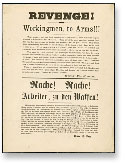 "Revenge! Workingmen to Arms!!" "Revenge! Workingmen to Arms!!"
Single-page letterpress broadside, May 4, 1886.
Broadsides, or handbills, like the so-called "Revenge Circular" were the "street literature" of the Haymarket era. They could be typeset and printed by the thousands quickly and cheaply on a small press and scattered throughout a large city in a matter of hours. Political groups like the Chicago anarchists favored the medium for urgent messages and announcements.
Donated to the Chicago Historical Society by the estate of Dr. Ernst Schmidt in 1900. Schmidt was organizer and treasurer of the Defense Committee, which raised funds for the legal defense of the Haymarket defendants; Schmidt was a German-born Chicago physician, socialist, and political activist.
|
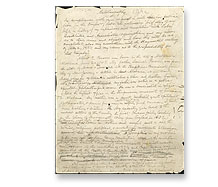
Opening page of Albert Parsons' autobiography.









|
|
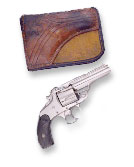 Police Officer's .38 caliber Smith & Wesson revolver with holster. Police Officer's .38 caliber Smith & Wesson revolver with holster.
Manufactured by Smith & Wesson, patented 1882. Made of nickel-plated steel, rubber, and leather.
The weapon and holster belonged to Chicago Police officer John Schermann at the time of the Haymarket Affair. Although Schermann was not, as has been claimed, present at in Haymarket Square on the night of May 4, the revolver was of the type carried by other police officers who were present.
Donated to the Chicago Historical Society by Officer Schermann's son, Charles Schermann, in 1968.
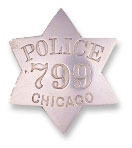 Police officer's star badge no. 799 Police officer's star badge no. 799
Brass. 3 1/2 x 3 inches. 1886.
The badge was worn by Officer Timothy Flavin, Chicago Police Department, a casualty of the Haymarket bombing.
Donated to the Chicago Historical Society in 1968 by Officer Flavin's grandson, John Flavin.
 Thure de Thulstrup. The anarchist riot in Chicago: a dynamite bomb exploding among the police. Thure de Thulstrup. The anarchist riot in Chicago: a dynamite bomb exploding among the police.
Wood-engraving published in Harper's Weekly, May 15, 1886.
Illustrated newspapers like Harper's Weekly brought the major events of the day to millions of readers throughout the United States and beyond. Because such newspapers catered mainly to the middle class and to the affluent, their coverage of the Haymarket Affair was heavily biased against the anarchists. Moreover, the illustrations of the Haymarket bombing and like events published in those journals were based on second-hand reports rather than on-the-spot coverage.
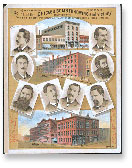 Scene of the Chicago bomb throwing and vicinity: together with portraits of persons convicted of complicity therewith. Scene of the Chicago bomb throwing and vicinity: together with portraits of persons convicted of complicity therewith.
Cabinet card photograph, published by the David Bradley Manufacturing Company, 1886 or 1887.
Photographic portraits of the Haymarket defendants and the sites connected with the bombing were circulated widely during and after the trial. At the time of the Haymarket Affair, photography was a relatively fast and inexpensive means of producing detailed, accurate images of people, places, and events. Because of the medium's fidelity to appearances, photographs were considered more literal, and thus more trustworthy, records than drawings, paintings, and prints. The reverse of this cabinet card photograph bears an advertisement for a plow manufactured by the Bradley firm.
Donated to the Chicago Historical Society by Mrs. W. R. Tuttle.
 Transcript of Witness Testimony and Cross-Examination during the Haymarket Trial. Transcript of Witness Testimony and Cross-Examination during the Haymarket Trial.
Typewritten text on 3,323 legal-size sheets of paper, with annotations and corrections in pencil and ink.
The transcript was probably produced by a professional stenographer present at the trial, and evidently employed either by the court or by the defending attorney. Transcripts were generally produced for purposes of analyzing testimony after the fact, in preparation for further argument and cross-examination, and for legal appeals of the conviction or the verdict. The purpose of the transcript was to record all testimony and cross-examination as faithfully as possible. At least three transcripts of the Haymarket witness testimony survive.
Donated to the Chicago Historical Society by the estate of Dr. Ernst Schmidt in 1900. Schmidt was organizer and treasurer of the Defense Committee, which raised funds for the legal defense of the Haymarket defendants; Schmidt was a German-born Chicago physician, socialist, and political activist.
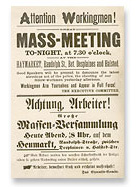 Evidence Books from the Haymarket Trial. Evidence Books from the Haymarket Trial.
329 pages of printed, handwritten, and typescript materials, and photographs.
The books include photographs or copies of the exhibits introduced as evidence by the prosecutors and defense attorneys and referenced by testimony. These include photographs of unexploded bombs, maps, and transcriptions and in some cases English translations, of anarchist and labor publications, and related materials.
Donated to the Chicago Historical Society by the estate of Dr. Ernst Schmidt in 1900. Schmidt was organizer and treasurer of the Defense Committee, which raised funds for the legal defense of the Haymarket defendants; Schmidt was a German-born Chicago physician, socialist, and political activist.
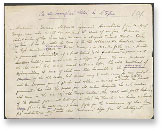 August Spies autobiography, 1886. August Spies autobiography, 1886.
Written by hand in ink on 33 sheets of paper, with extensive revisions and annotations in blue and red inks and pencil.
The manuscript was written and revised by Spies between the August 1886 sentencing of Spies and the other Haymarket defendants and November 1886 as the raw form, or draft, for a published autobiography. A slightly edited version was published, as were the autobiographies of fellow defendants Albert Parsons, George Engel, Adolph Fischer, Samuel Fielden, Michael Schwab, and Oscar Neebe, in Knights of Labor, a newspaper published by the Chicago organization of the Knights of Labor. These autobiographies were published beginning in October 1886 and continued through April 1887.
Donated to the Chicago Historical Society by the estate of Dr. Ernst Schmidt in 1900. Schmidt was organizer and treasurer of the Defense Committee, which raised funds for the legal defense of the Haymarket defendants; Schmidt was a German-born Chicago physician, socialist, and political activist.
 
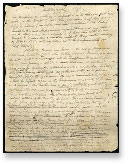 Albert Parsons autobiography, 1886. Albert Parsons autobiography, 1886.
Written by hand in pencil and ink on 51 sheets of paper, with revisions and annotations believed to be by Parsons.
The manuscript was written and revised between the August 1886 sentencing of Parsons and the other Haymarket defendants and October 1886 as the raw form, or draft, for a published autobiography. A slightly edited version was published, as were the autobiographies of fellow defendants August Spies, George Engel, Adolph Fischer, Samuel Fielden, Michael Schwab, and Oscar Neebe, in Knights of Labor, a newspaper published by the Chicago organization of the Knights of Labor. These autobiographies were published beginning in October 1886 and continued through April 1887.
Donated to the Chicago Historical Society by the estate of Dr. Ernst Schmidt in 1900. Schmidt was organizer and treasurer of the Defense Committee which raised funds for the legal defense of the Haymarket defendants; Schmidt was a German-born Chicago physician, socialist, and political activist.
 
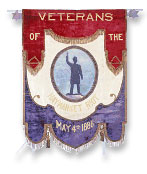 Parade banner of the Veterans of the Haymarket Riot. Parade banner of the Veterans of the Haymarket Riot.
Velvet, taffeta, satin, bullion, tin. 59 1/4 x 44 1/2". 1895.
The banner was carried in parades by police veterans of the Haymarket Riot.
Donated to the Chicago Historical Society in 1933 by Captain Frank P. Tyrell, Chicago Police Department.
|

Chicago History Museum
Clark Street at North Avenue Chicago, Illinois 60614-6099
Phone 312.642.4600 Fax 312.266.2077
|
|











